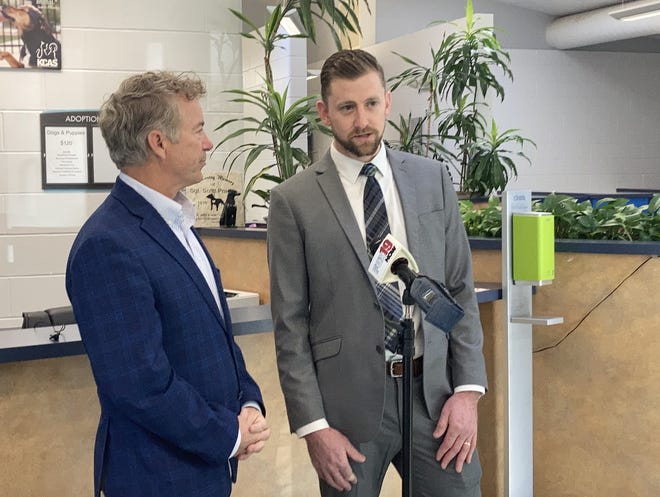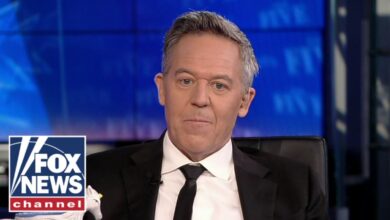
Some gleeful professionals are sharing their joy on social media after finding out a federal program has wiped out their student debt.
A Kentucky doctor on Twitter said he reapplied for the public service loan forgiveness program after working a decade at a nonprofit organization and recently received notice that his medical school loans had been forgiven.
"In shock," wrote Dr. Lee Dossett.
Dossett took advantage of a program that originally failed to fulfill its promise of offering student debt relief to thousands of public workers, including teachers, police officers and firefighters.
President Joe Biden's administration overhauled the Public Service Loan Forgiveness program in October. For years, thousands of borrowers had applied for forgiveness under the program, but nearly all of them were rejected by the federal government.
Data from the department now show roughly 70,000 borrowers have qualified for nearly $5 billion in relief since October.
Get the latest on student loans, financial news:Subscribe to the Daily Money newsletter.
The overhaul was designed to let borrowers correct errors and count payments they were trying to make toward the program, plus consolidate loans or get in the right repayment plan to be eligible. It is expected to shorten the amount of time more than 550,000 borrowers – those who have already consolidated their loans – are required to make payments to qualify for forgiveness, the government said.
If you have student loans and wonder if your job qualifies, here are the steps you can take to explore getting relief.

What is Public Service Loan Forgiveness? How did it originate?
The Public Service Loan Forgiveness is a program that was launched in 2007 in an effort to steer more college graduates into public service. As long as they made 10 years of payments on their federal student loans, the program promised to erase the remainder.
The program, however, proved anything but forgiving.
Before the October changes, only 16,000 borrowers had seen their debt forgiven, or discharged, according to the Education Department. About 1.3 million people are trying to have their debts discharged through the program.
One of the most problematic pieces of Public Service Loan Forgiveness: Many borrowers had the wrong type of loan and didn't realize they weren't eligible for relief.
When the loan forgiveness program was first introduced, many of the loans offered from the federal government were Family Federal Education Loans (FFEL), or loans made through private entities but insured by the federal government.
The government stopped offering those loans in 2010 and now relies on direct loans – the kind eligible for forgiveness. The Education Department said about 60% of borrowers with an approved employer hold FFEL loans.
Who is eligible for student loan forgiveness?
The government previously restricted eligibility for the Public Service Loan Forgiveness program to only certain types of federal student loans and specific repayment plans.
However, through October 2022, borrowers who have made 10 years worth of payments while in a qualifying job – such as positions in federal, state or local governments, a nonprofit organization or the U.S. military – will now be eligible for loan relief no matter what kind of federal loan or repayment plan they have.
Past loan payments that were previously ineligible will now count, moving some borrowers closer to forgiveness, also known as having your loan "discharged." That is expected to especially help those borrowers with Federal Family Education Loans.
Among other changes, the department will allow military members to count time on active duty toward the 10 years, even if they put a pause on making their payments during that time.
How do I figure out if my past or current employer qualifies for PSLF?
Use this help tool of the Federal Student Aid website to check if you work for a qualifying employer: https://studentaid.gov/pslf/
It provides information on which employers meet requirements for the Public Service Loan Forgiveness program.
How do I check which federal loans I have?
If borrowers are unsure about what type of loan they have, they can request that information from their loan servicer or they can check on the federal government's website for financial aid, according to Betsy Mayotte, president of the Institute of Student Loan Advisors.
If you don't know what kind of federal loans you have, you can see which loans by logging into your account on StudentAid.gov, going to the My Aid page and scrolling down to the Loan Breakdown section.
If I qualify, what steps do I need to take?
Changes to the loan forgiveness program will take place in two parts.
The agency will first loosen some of the rules that had prevented eligible borrowers from discharging their loans, via a limited waiver. The government, for example, will allow payments on any of a person's loans to count toward the total number required for forgiveness.
The Public Service Loan Forgiveness waiver will be available to borrowers who have direct loans, Federal Family Education Loans and Perkins Loans.
Parent PLUS loans are not eligible under the limited waiver.
The department said it would automatically credit borrowers who already have direct loans and have proved they work in an eligible field. Others who haven't enrolled in the program or have ineligible federal loans will have to apply for forgiveness, which may require them to consolidate their loans. Borrowers will have until October 2022 to apply.
To find out more about loan consolidation, visit StudentAid.gov/Manage-Loans/Consolidation.
The Education Department also plans to review all Public Service Loan Forgiveness applications that had been denied and to give federal employees automatic credit toward forgiveness.
Other changes will come about more slowly via regulations made by "rule-making," a lengthy and complicated bureaucratic back-and-forth between the government and other stakeholders.
For more information, visit StudentAid.gov/PSLFWaiver.
How do you receive credit for past payments under the new rules?
For a limited time, borrowers may get credit for past payments made on loans that would otherwise not qualify for the Public Service Loan Forgiveness program.
There are two requirements to receive additional qualifying payments: full-time employment and loan consolidation.
For instance, you must have worked full-time for a qualifying employer when prior payments were made, according to Federal Student Aid.
Some part-time workers may qualify under certain circumstances. Say you were employed in more than one qualifying part-time job at the same time. You would be considered full-time if you worked a combined average of at least 30 hours per week.
It may take several months for a borrower's account information to reflect the new payment count, according to Federal Student Aid.
How far back can I get credit for payments?
To be sure, you can only receive credit for payments made after Oct. 1, 2007, since that is when the Public Service Loan Forgiveness program began.
For any period you may receive additional qualifying payments, you must file an application. Public Service Loan Forgiveness & Temporary Expanded PSLF Certification & Application.
Who may need to consolidate their loans?
If you have Federal Family Education Loan Program loans, Federal Perkins Loans or other types of federal student loans that aren’t direct loans, you must consolidate them into the direct loan program by Oct. 31, 2022, according to Federal Student Aid.
Borrowers can't receive credit for payments if they consolidate after that date. Once the consolidation process is complete, submit a PSLF form to your loan servicer.
Source link







